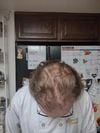community I’m someone who was supposed to be prematurely bald. My hair loss started at 15, I started finasteride at 17, switched to dutasteride at 18, now at 19 this is my situation, thoughts? I know my life wouldn’t be that different if I was bald, I just feel more confident with hair..
A user's journey with hair loss, starting with finasteride at age 17 and switching to dutasteride at 18. The post provides insight on how minoxidil helped initially but quitting it caused some regrowth that was regained when switching to dutasteride. There is also discussion about starting finasteride as young as 17 years old for those who may be worried about potential physical development issues.
